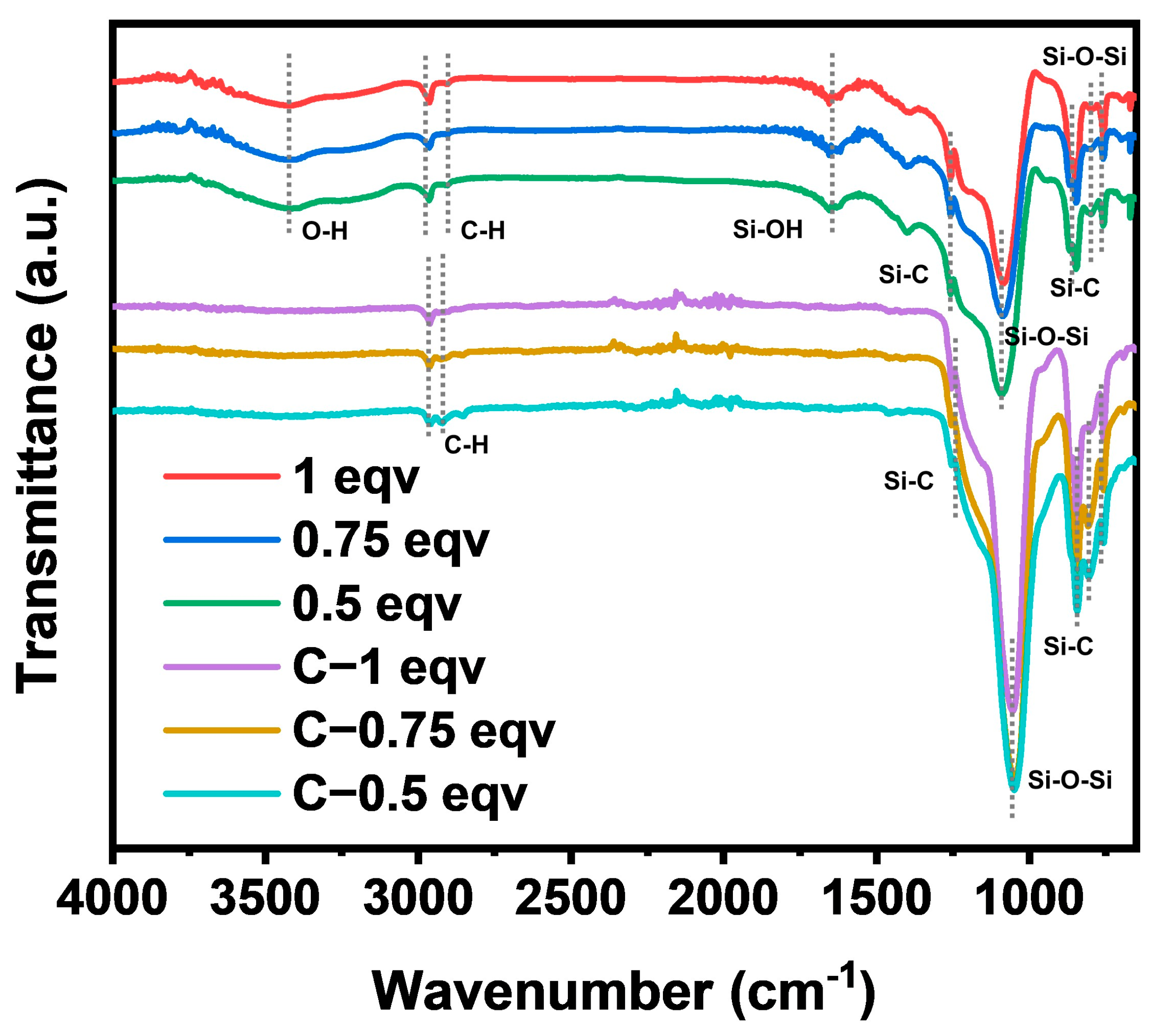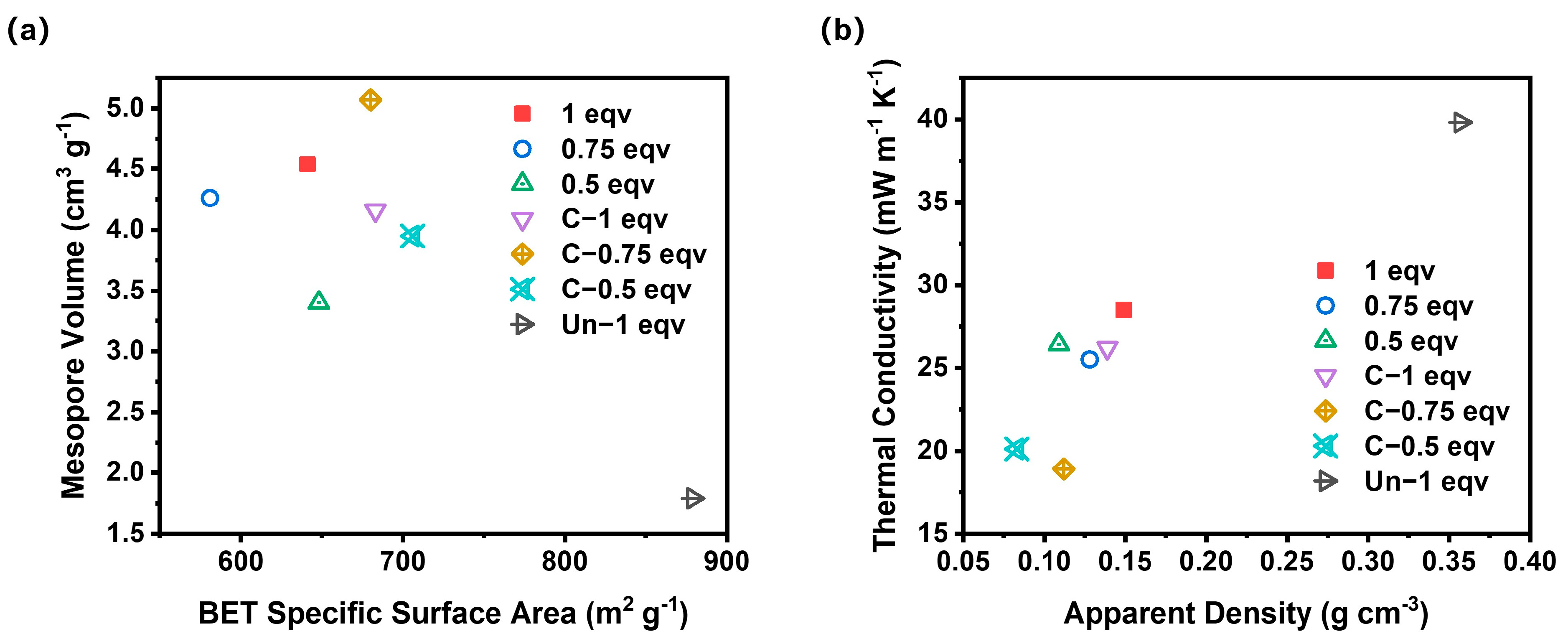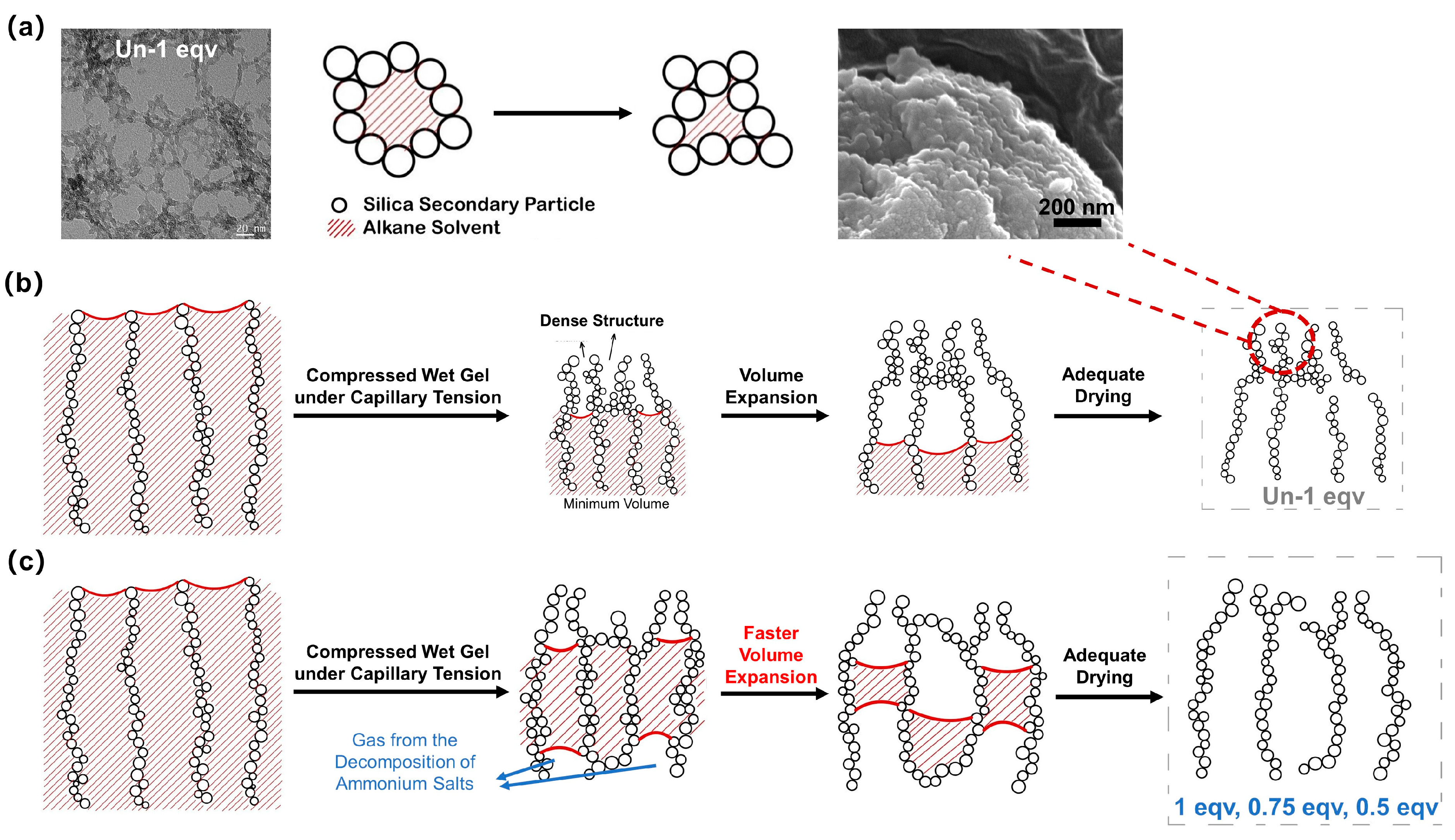Enhancing Mesopore Volume and Thermal Insulation of Silica Aerogel via Ambient Pressure Drying-Assisted Foaming Method
Abstract
1. Introduction
2. Materials and Methods
2.1. Materials
2.2. Preparation of Granular Silica Aerogels (1 eqv, 0.75 eqv, and 0.5 eqv) with APD-Assisted Foaming Method
2.3. Preparation of Calcined Silica Aerogels (C-1 eqv, C-0.75 eqv, and C-0.5 eqv) to Remove Residual Ammonium Salts
2.4. Preparation of General Silica Aerogel (Un-1 eqv) via Ambient Pressure Drying as the Comparison Group
2.5. Characterization and Measurement
3. Results and Discussion
3.1. Chemical Structures of Silica Aerogels Prepared by the APD-Assisted Foaming Method
3.2. Morphology of the Skeleton and Pores of Silica Aerogels Prepared by the APD-Assisted Foaming Method
3.3. Analysis of Mesopores and Thermal Conductivities of Silica Aerogels Prepared by the APD-Assisted Foaming Method
3.4. Explanations for Spring-Back Phenomenon and the APD-Assisted Foaming Method
4. Conclusions
Supplementary Materials
Author Contributions
Funding
Institutional Review Board Statement
Informed Consent Statement
Data Availability Statement
Conflicts of Interest
References
- Gesser, H.D.; Goswami, P.C. Aerogels and related porous materials. Chem. Rev. 1989, 89, 765–788. [Google Scholar] [CrossRef]
- Ziegler, C.; Wolf, A.; Liu, W.; Herrmann, A.-K.; Gaponik, N.; Eychmüller, A. Modern Inorganic Aerogels. Angew. Chem. Int. Ed. 2017, 56, 13200–13221. [Google Scholar] [CrossRef] [PubMed]
- Jelle, B.P.; Gustavsen, A.; Baetens, R. The path to the high performance thermal building insulation materials and solutions of tomorrow. J. Build. Phys. 2010, 34, 99–123. [Google Scholar] [CrossRef]
- Baetens, R.; Jelle, B.P.; Thue, J.V.; Tenpierik, M.J.; Grynning, S.; Uvsløkk, S.; Gustavsen, A. Vacuum insulation panels for building applications: A review and beyond. Energy Build. 2010, 42, 147–172. [Google Scholar] [CrossRef]
- Jelle, B.P. Traditional, state-of-the-art and future thermal building insulation materials and solutions—Properties, requirements and possibilities. Energy Build. 2011, 43, 2549–2563. [Google Scholar] [CrossRef]
- Hu, F.; Wu, S.; Sun, Y. Hollow-Structured Materials for Thermal Insulation. Adv. Mater. 2019, 31, 1801001. [Google Scholar] [CrossRef] [PubMed]
- Pajonk, G.M. Some applications of silica aerogels. Colloid Polym. Sci. 2003, 281, 637–651. [Google Scholar] [CrossRef]
- Hench, L.L.; West, J.K. The sol-gel process. Chem. Rev. 1990, 90, 33–72. [Google Scholar] [CrossRef]
- Gurav, J.L.; Jung, I.-K.; Park, H.-H.; Kang, E.S.; Nadargi, D.Y. Silica Aerogel: Synthesis and Applications. J. Nanomater. 2010, 2010, 409310. [Google Scholar] [CrossRef]
- Zhang, X.; Zhao, X.; Xue, T.; Yang, F.; Fan, W.; Liu, T. Bidirectional anisotropic polyimide/bacterial cellulose aerogels by freeze-drying for super-thermal insulation. Chem. Eng. J. 2020, 385, 123963. [Google Scholar] [CrossRef]
- Shao, Z.D.; Cheng, X.; Zheng, Y.M. Facile co-precursor sol-gel synthesis of a novel amine-modified silica aerogel for high efficiency carbon dioxide capture. J. Colloid Interface Sci. 2018, 530, 412–423. [Google Scholar] [CrossRef] [PubMed]
- Halim, Z.A.A.; Yajid, M.A.M.; Hamdan, H. Effects of Solvent Exchange Period and Heat Treatment on Physical and Chemical Properties of Rice Husk Derived Silica Aerogels. Silicon 2021, 13, 251–257. [Google Scholar] [CrossRef]
- Wu, X.; Zhong, K.; Ding, J.; Shen, X.; Cui, S.; Zhong, Y.; Ma, J.; Chen, X. Facile synthesis of flexible and hydrophobic polymethylsilsesquioxane based silica aerogel via the co-precursor method and ambient pressure drying technique. J. Non-Cryst. Solids 2020, 530, 119826. [Google Scholar] [CrossRef]
- Stojanovic, A.; Zhao, S.; Angelica, E.; Malfait, W.J.; Koebel, M.M. Three routes to superinsulating silica aerogel powder. J. Sol-Gel Sci. Technol. 2019, 90, 57–66. [Google Scholar] [CrossRef]
- Prakash, S.S.; Brinker, C.J.; Hurd, A.J.; Rao, S.M. Silica aerogel films prepared at ambient pressure by using surface derivatization to induce reversible drying shrinkage. Nature 1995, 374, 439–443. [Google Scholar] [CrossRef]
- Li, T.; Du, A.; Zhang, T.; Ding, W.; Liu, M.; Shen, J.; Zhang, Z.; Zhou, B. Efficient preparation of crack-free, low-density and transparent polymethylsilsesquioxane aerogels via ambient pressure drying and surface modification. RSC Adv. 2018, 8, 17967–17975. [Google Scholar] [CrossRef] [PubMed]
- Hayase, G.; Kanamori, K.; Maeno, A.; Kaji, H.; Nakanishi, K. Dynamic spring-back behavior in evaporative drying of polymethylsilsesquioxane monolithic gels for low-density transparent thermal superinsulators. J. Non-Cryst. Solids 2016, 434, 115–119. [Google Scholar] [CrossRef]
- Çok, S.S.; Gizli, N. Hydrophobic silica aerogels synthesized in ambient conditions by preserving the pore structure via two-step silylation. Ceram. Int. 2020, 46, 27789–27799. [Google Scholar] [CrossRef]
- Wei, T.Y.; Chang, T.F.; Lu, S.Y.; Chang, Y.C. Preparation of Monolithic Silica Aerogel of Low Thermal Conductivity by Ambient Pressure Drying. J. Am. Ceram. Soc. 2007, 90, 2003–2007. [Google Scholar] [CrossRef]
- Pisal, A.A.; Venkateswara Rao, A. Development of hydrophobic and optically transparent monolithic silica aerogels for window panel applications. J. Porous Mater. 2017, 24, 685–695. [Google Scholar] [CrossRef]
- Rao, A.P.; Rao, A.V.; Pajonk, G.M. Hydrophobic and physical properties of the ambient pressure dried silica aerogels with sodium silicate precursor using various surface modification agents. Appl. Surf. Sci. 2007, 253, 6032–6040. [Google Scholar] [CrossRef]
- Dong, H.; Reidy, R.F.; Brennan, J.D. Shrinkage and Springback Behavior of Methylsilsesquioxanes Prepared by an Acid/Base Two-Step Processing Procedure. Chem. Mater. 2005, 17, 6012–6017. [Google Scholar] [CrossRef]
- Han, X.; Hassan, K.T.; Harvey, A.; Kulijer, D.; Oila, A.; Hunt, M.R.C.; Šiller, L. Bioinspired Synthesis of Monolithic and Layered Aerogels. Adv. Mater. 2018, 30, 1706294. [Google Scholar] [CrossRef] [PubMed]
- Lu, J.; Wang, J.; Hassan, K.T.; Talmantaite, A.; Xiao, Z.; Hunt, M.R.C.; Šiller, L. Morphology control of nickel nanoparticles prepared in situ within silica aerogels produced by novel ambient pressure drying. Sci. Rep. 2020, 10, 11743. [Google Scholar] [CrossRef] [PubMed]
- ISO 1183-1:2019; Plastics—Methods for Determining the Density of Non-Cellular Plastics. International Organization for Standardization: Geneva, Switzerland, 2019.
- Xi, S.; Wang, X.; Liu, T.; Zhang, Z.; Zhang, X.; Shen, J. Moisture-Resistant and Mechanically Strong Polyimide-Polymethylsilsesquioxane Hybrid Aerogels with Tunable Microstructure. Macromol. Mater. Eng. 2021, 306, 2000612. [Google Scholar] [CrossRef]
- Nah, H.-Y.; Kim, Y.; Kim, T.; Lee, K.-Y.; Parale, V.G.; Lim, C.-H.; Seo, J.-Y.; Park, H.-H. Comparisonal studies of surface modification reaction using various silylating agents for silica aerogel. J. Sol-Gel Sci. Technol. 2020, 96, 346–359. [Google Scholar] [CrossRef]
- Li, Z.; Zhao, S.; Koebel, M.M.; Malfait, W.J. Silica aerogels with tailored chemical functionality. Mater. Des. 2020, 193, 108833. [Google Scholar] [CrossRef]
- Zhao, Z.; Cui, Y.; Kong, Y.; Ren, J.; Jiang, X.; Yan, W.; Li, M.; Tang, J.; Liu, X.; Shen, X. Thermal and Mechanical Performances of the Superflexible, Hydrophobic, Silica-Based Aerogel for Thermal Insulation at Ultralow Temperature. ACS Appl. Mater. Interfaces 2021, 13, 21286–21298. [Google Scholar] [CrossRef]
- Luo, W.; Shu, X.; Xu, B.; Liu, Z.; Ou, Z.; Liu, J. Influence of Hydrolysis Time on Properties of SiO2 Aerogels Prepared by Ambient Pressure Drying. Arab. J. Sci. Eng. 2021, 46, 477–484. [Google Scholar] [CrossRef]
- Hüsing, N.; Schubert, U. Aerogels-Airy Materials: Chemistry, Structure, and Properties. Angew. Chem. Int. Ed. 1998, 37, 22–45. [Google Scholar] [CrossRef]
- Huber, L.; Zhao, S.; Malfait, W.J.; Vares, S.; Koebel, M.M. Fast and Minimal-Solvent Production of Superinsulating Silica Aerogel Granulate. Angew. Chem. Int. Ed. 2017, 56, 4753–4756. [Google Scholar] [CrossRef] [PubMed]
- Schubert, U. Chemistry and Fundamentals of the Sol-Gel Process. In The Sol-Gel Handbook; Wiley: Hoboken, NJ, USA, 2015; pp. 1–28. [Google Scholar]







| Sample Name | ρ a (g cm−3) | Porosity b (%) | BET Specific Surface Area (m2 g−1) | Mesopore Volume c (cm3 g−1) | Average Pore Diameter d (nm) | Th.Conductivity e (mW m−1 K−1) |
|---|---|---|---|---|---|---|
| 1 eqv | 0.149 ± 0.007 | 92.6 | 641 | 4.54 | 25.5 | 28.5 ± 0.3 |
| 0.75 eqv | 0.128 ± 0.013 | 93.6 | 581 | 4.26 | 25.5 | 25.5 ± 0.2 |
| 0.5 eqv | 0.109 ± 0.009 | 94.6 | 648 | 3.40 | 29.4 | 26.4 ± 0.2 |
| C-1 eqv | 0.139 ± 0.006 | 93.1 | 683 | 4.16 | 29.4 | 26.2 ± 0.3 |
| C-0.75 eqv | 0.112 ± 0.009 | 94.4 | 680 | 5.07 | 29.4 | 18.9 ± 0.2 |
| C-0.5 eqv | 0.083 ± 0.014 | 95.9 | 706 | 3.95 | 29.4 | 20.1 ± 0.2 |
| Un-1 eqv | 0.357 ± 0.006 | 82.2 | 879 | 1.79 | 6.8 | 39.8 ± 0.1 |
Disclaimer/Publisher’s Note: The statements, opinions and data contained in all publications are solely those of the individual author(s) and contributor(s) and not of MDPI and/or the editor(s). MDPI and/or the editor(s) disclaim responsibility for any injury to people or property resulting from any ideas, methods, instructions or products referred to in the content. |
© 2024 by the authors. Licensee MDPI, Basel, Switzerland. This article is an open access article distributed under the terms and conditions of the Creative Commons Attribution (CC BY) license (https://creativecommons.org/licenses/by/4.0/).
Share and Cite
Guo, J.; Luo, K.; Zou, W.; Xu, J.; Guo, B. Enhancing Mesopore Volume and Thermal Insulation of Silica Aerogel via Ambient Pressure Drying-Assisted Foaming Method. Materials 2024, 17, 2641. https://doi.org/10.3390/ma17112641
Guo J, Luo K, Zou W, Xu J, Guo B. Enhancing Mesopore Volume and Thermal Insulation of Silica Aerogel via Ambient Pressure Drying-Assisted Foaming Method. Materials. 2024; 17(11):2641. https://doi.org/10.3390/ma17112641
Chicago/Turabian StyleGuo, Jinjing, Kaiqiang Luo, Wenqi Zou, Jun Xu, and Baohua Guo. 2024. "Enhancing Mesopore Volume and Thermal Insulation of Silica Aerogel via Ambient Pressure Drying-Assisted Foaming Method" Materials 17, no. 11: 2641. https://doi.org/10.3390/ma17112641
APA StyleGuo, J., Luo, K., Zou, W., Xu, J., & Guo, B. (2024). Enhancing Mesopore Volume and Thermal Insulation of Silica Aerogel via Ambient Pressure Drying-Assisted Foaming Method. Materials, 17(11), 2641. https://doi.org/10.3390/ma17112641








